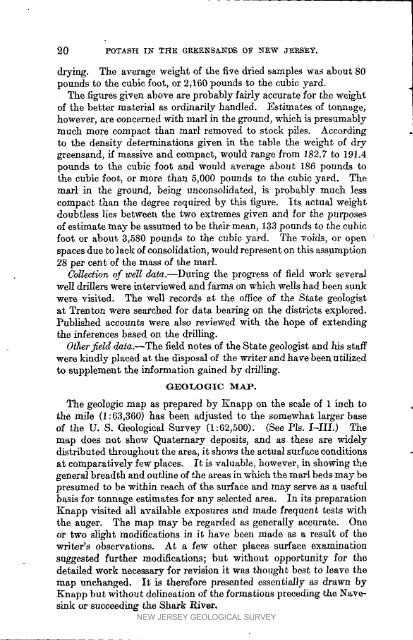Bulletin 23. Potash in the Greensands of NJ, 1923 - State of New ...
Bulletin 23. Potash in the Greensands of NJ, 1923 - State of New ...
Bulletin 23. Potash in the Greensands of NJ, 1923 - State of New ...
You also want an ePaper? Increase the reach of your titles
YUMPU automatically turns print PDFs into web optimized ePapers that Google loves.
20 POTASH IN TttE GREENS&IWDS OF NRW JEILSEY.<br />
dry<strong>in</strong>g. ]'he average weight <strong>of</strong> <strong>the</strong> five dried samples was about 80<br />
pounds to <strong>the</strong> cubic foot, or 2,160 pounds to <strong>the</strong> cubic yard.<br />
The figures given above are probably fairly accurate for <strong>the</strong> weight<br />
<strong>of</strong> <strong>the</strong> better material as ord<strong>in</strong>arily handled. Estimates <strong>of</strong> tonnage,<br />
however, are concerned with marl <strong>in</strong> <strong>the</strong> ground, which is presumably<br />
much more compact than mar] removed to stock piles. Accord<strong>in</strong>g<br />
to <strong>the</strong> density determ<strong>in</strong>ations given <strong>in</strong> <strong>the</strong> table <strong>the</strong> weight <strong>of</strong> dry<br />
greensand, if massive and compact, would range from 182.7 to 191.4<br />
pounds to <strong>the</strong> cubic foot and would average about 186 pounds to<br />
<strong>the</strong> cubic foot, or more than 5,000 pounds to <strong>the</strong> cubic yard. The<br />
marl <strong>in</strong> <strong>the</strong> ground, be<strong>in</strong>g unconsolidated, is probably much less<br />
compact than <strong>the</strong> degree required by this figure. Its actual weight<br />
doubtless lies between <strong>the</strong> two extremes given and for <strong>the</strong> purposes<br />
<strong>of</strong> estimate may be assumed to be <strong>the</strong>ir mean, 133 pounds to <strong>the</strong> cubic<br />
foot or about 3,580 pounds to <strong>the</strong> cubic yard. The voids, or open<br />
spaces due to lack <strong>of</strong> consolidation, would represent on this asspmption<br />
28 per cent <strong>of</strong> <strong>the</strong> mass <strong>of</strong> <strong>the</strong> marl.<br />
Collection <strong>of</strong> well data.--Dur<strong>in</strong>g <strong>the</strong> progress <strong>of</strong> field work several<br />
well drillers were <strong>in</strong>terviewed and farms on which wells had been sunk<br />
were visited. The well records at <strong>the</strong> <strong>of</strong>fice <strong>of</strong> <strong>the</strong> <strong>State</strong> geologist<br />
at Trenton were searched for data bear<strong>in</strong>g on <strong>the</strong> districts explored.<br />
Published accounts were also reviewed with <strong>the</strong> hope <strong>of</strong> extend<strong>in</strong>g<br />
_he <strong>in</strong>ferences based on <strong>the</strong> drill<strong>in</strong>g.<br />
O<strong>the</strong>rfield data.--The field notes <strong>of</strong> <strong>the</strong> <strong>State</strong> geologist and his staff<br />
were k<strong>in</strong>dly placed at <strong>the</strong> disposal <strong>of</strong> <strong>the</strong> writer and have been utilized<br />
to supplement <strong>the</strong> <strong>in</strong>formation ga<strong>in</strong>ed by drill<strong>in</strong>g.<br />
GEOLOGIC MA] _.<br />
The geologic map as prepared by Knapp on <strong>the</strong> scale <strong>of</strong> 1 <strong>in</strong>ch to<br />
<strong>the</strong> mile (1:63,360) has been adjusted to <strong>the</strong> somewhat larger base<br />
<strong>of</strong> <strong>the</strong> U. S. Geological Survey (1:62,500). (See Pls. I-III.) The<br />
map does not show Quaternary deposits, and as <strong>the</strong>se are widely<br />
distributed throughout <strong>the</strong> area, it shows <strong>the</strong> actual anrfaco conditions<br />
at comparatively few places. It is valuable, however, <strong>in</strong> show<strong>in</strong>g <strong>the</strong><br />
general breadth and outl<strong>in</strong>e <strong>of</strong> <strong>the</strong> areas <strong>in</strong> which <strong>the</strong> marl beds may be<br />
presumed to be with<strong>in</strong> reach <strong>of</strong> <strong>the</strong> surface and may serve as a useful<br />
basis for tonnage estimates for any selected area. In its preparation<br />
Kmapp visited all available exposures and made frequent tests with<br />
<strong>the</strong> auger. The map may be regarded as generally accurate. One<br />
or two slight modifications <strong>in</strong> it have been made as a result <strong>of</strong> <strong>the</strong><br />
writer's observations. At a few o<strong>the</strong>r places surface exam<strong>in</strong>ation<br />
suggested fur<strong>the</strong>r modifications; but without opportunity for <strong>the</strong><br />
detailed work necessary for revision it was thought best to leave <strong>the</strong><br />
map unchanged. It is <strong>the</strong>refore presented essentially as drawn by<br />
Knapp but without del<strong>in</strong>eation <strong>of</strong> <strong>the</strong> formations preced<strong>in</strong>g <strong>the</strong> Naves<strong>in</strong>k<br />
or succeed<strong>in</strong>g <strong>the</strong> Shark River.<br />
NEW JERSEY GEOLOGICAL SURVEY

















